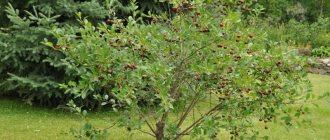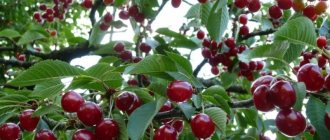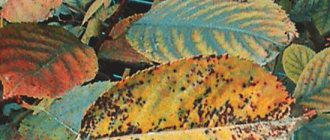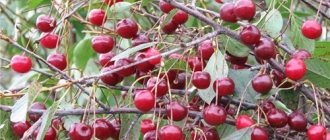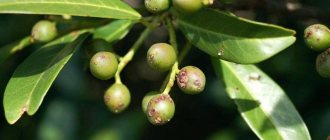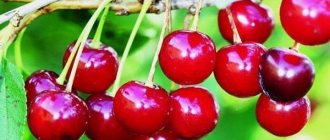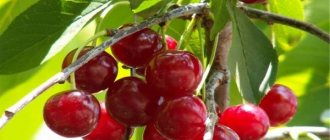Cherry in Memory of Vavilov
Bred from unidentified cherry seedlings.
A very large tree with round fruits. The fruits ripen in early July, the flesh is dark red, very juicy, and easily separated from the stone. Pollinated by Seedling No. 1 varieties and cherry varieties. It bears fruit 4 years after planting. Winter-hardy, very productive, resistant to fungus. Cherry Zarya of the Volga Region
A hybrid variety from the Krasa Severa and Vladimirskaya varieties, medium in size with a spherical crown. It bears fruit 4 years after planting. The fruits ripen in early July, have juicy dark red pulp, and a sweet and sour taste. Productivity is good, it tolerates winter well, and is not susceptible to fungus.
Other types of cherries
Felt cherry
A small plant, in the form of a shrub, native to China and Mongolia. Very frost-resistant, early ripening, high yield, resistant to fungus. The fruits cling to the branch, on very short stalks, sweet in taste, scarlet in color. For pollination, you need to plant several bushes nearby.
Sakura, Japanese cherry, also known as finely serrated cherry
Sakura is known to everyone for its beautiful blossoms - the trees seem to be covered with a pink or white cloud. People from all over the world come to see the cherry blossom gardens during the season. Many people plant a sakura tree in their garden precisely in order to enjoy the magnificent flowers and aroma.
Real, “pure” sakura fruits are inedible: they are small, black berries, almost entirely consisting of seeds, similar to bird cherry fruits. However, by crossing Japanese and European varieties, varieties with large and tasty berries were developed; in Japanese they are called sakurambo. They taste more like cherries than cherries. The berries are light pink to dark red, almost black, with dense pulp. Popular varieties: Satonisiki, resistant to dampness, and Naniye, which has very large and tasty fruits, unfortunately, highly susceptible to rotting in high humidity. These varieties appeared in Japan relatively recently, and are still considered an expensive delicacy.
Varieties suitable for cultivation in central Russia
These varieties have average frost resistance. Little susceptible to fungal diseases. The most suitable varieties for this region are “Sashenka” and “Garlyanda”
Sashenka is a tree 4 meters high, with a medium crown. Steadily begins to bear fruit in the 5th year of ripening. The variety is not susceptible to fungus and garden parasites. The fruits are medium-sized and round in shape. Ripening begins in early July.
Garland is a tree 3 meters high, a very dense crown with dark green leaves. The berries are large in size, dark in color, and have a small seed. Fruits when the tree reaches 3 years of age. Ripening occurs in mid-June. The variety is not susceptible to garden parasites and has good resistance to drought and frost.
Today, science does not stand still. Every year, breeders develop new and improve existing varieties of cherries. With the right variety and timely care, cherries can produce a rich harvest every year.
Cherry Chocolate Girl
The variety was bred at the end of the 20th century. The fruits are burgundy. This is a small tree. Its height is no more than 2.5 m. The combination of branches and leaves form a pyramidal shape.
The plant looks more like a shrub than a tree. Produces many fruits. The flowers are painted white.
Blooms in May. Cherries ripen in July. But the timing may vary in different regions. They taste sweetish, slightly sour.
The weight of one fruit is up to 3.5 g. The seed is easily separated from the pulp. Productivity – up to 15 kg. Fruiting begins 3 years after planting. Grows up to 20 years.
- cold resistance
- early ripening of cherries
- undemanding to soil moisture
- prone to infection with mycoses.
Chocolate cherry is a young variety. Therefore, its seedlings are not very easy to find on sale. To grow it, you need to choose a well-lit part of the garden.
The tree must be pruned every year. You can water during flowering and fruit formation. Feed only 3 years after planting . Then once every 4 years.
Can be grown in any region of Russia.
According to gardeners:
Cherry seedlings T-shirt
Call! We'll help you choose
Characteristics of the fruit: the fruits are medium-sized, their weight is 3.1 g. Their shape is oval-flattened. The dark red skin becomes almost black when ripe. The flesh is tender, soft and slightly juicy. The taste is fresh-sweet. The stone easily separates from the pulp. Ripening period: early. Beginning of fruiting: from 5-6 years. Productivity: per tree 45-55 kg. Tree: medium-sized. The narrow crown becomes highly oval and slightly sparse with age. Oval shaped foliage. Features of the variety: the main feature of this variety is early ripening. In addition, the tree is quite frost-resistant. Recommendations for planting: you need to choose a place for planting carefully so that the seedling grows 4 meters from another tree. The hole should be deep and wide, approximately one meter by one meter. When starting planting, you need to cut off 1/3 of the root. So, fill the hole with fertile soil, compacting it from the edge of the hole to the center. Create a small earthen edge around the planting hole to retain water. Water the plant until completely saturated with water. We also recommend using root formation stimulants. After planting, the fruit seedling must be cut to 1/3 of its height for good growth.
Recommended planting period: seedlings can be planted all year round, with the exception of winter. Best in spring or autumn.
You can buy Mika Cherry seedlings in Moscow without leaving your home! By ordering seedlings from our online store with home delivery.
eseeds.ru
Cherry-cherry hybrids
Varieties obtained by crossing cherries and sweet cherries are usually called dukes. About 30 species of such hybrids grow in Russia. Several varieties will be described below.
Kharitonovskaya
Cherry with a medium ripening period. The height of the tree is 2.5 - 3 m. The branches form a spherical shape.
The cherries are dark red in color, juicy, weighing about 5 g. Sweet and sour. The stone can be easily separated from the pulp.
But she's quite big. They have good transportability. Fruiting occurs in the 4th year of planting.
It is capable of pollinating on its own, but for good fruiting the following varieties should be planted next to it:
- it is rarely affected by fungal diseases.
- not suitable for cultivation in areas with severe frosts.
Podbelskaya
Tall tree - up to 5 m. The collection of branches forms a round shape.
Cherries are dark red in color, weighing up to 5 g. Fibrous. The taste is sweet and sour.
Fruiting begins 4–5 years after planting, in mid-summer. The fruits ripen gradually. The seed comes away from the pulp without difficulty. Can be used in any form.
This variety is not able to withstand strong drops in air temperature.
The plant's pollen is sterile. It is recommended to plant cherries next to it, or such varieties of cherries as:
- English early
- Lotovaya
- Anadolskaya
- May Duke
- Griot Ostheim
The combination of branches and leaves forms a pyramidal shape. The flowers are large and white. The fruits are dark red in color, weighing up to 10 g.
They taste sweet, similar to cherries. But the aroma is reminiscent of cherries. Full fruiting begins in the 4th year of planting. Productivity – 10 – 15 kg per tree.
The miracle bears fruit every year. The first harvest can be harvested at the end of June. This is a cross-pollinated cherry variety.
To get a harvest, you need to plant cherries next to it.
The branches of a tree have the property of stretching upward. To properly form the crown, some gardeners tie weights to the branches. The variety is better suited for warm regions of the country.
It is not worth planting in central Russia. The landing site must be chosen as windless, bright, and without close groundwater.
The plant must be pruned within 5 years. In the first year of life, during spring pruning, 1/6 of the shoots are cut off.
- The variety is resistant to fungal diseases.
- Cherry Miracle cannot become a pollinator - its pollen is sterile.
Baby
Plant height is 2 – 2.5 m. It grows very quickly. Not able to pollinate on its own.
Flowering begins in May. Early - bears fruit in June, 3 - 4 years after planting. 1 cherry weighs about 5 g. The color is dark red.
Up to 15 kg of crop is harvested from one plant. Pleasant to the taste, slightly sour. They are mainly used fresh, but they are also suitable for preparation.
Transportable. They are stored for no more than 10 days.
- high yield
- disease resistance
- endurance to strong drops in air temperature
- pleasant taste of fruits
- Susceptible to certain diseases
The best neighbors for her:
Shpanka
The variety was bred by Ukrainian breeders. Trees with early fruit ripening.
It is popular not only in its own country, but also abroad. These are tall plants up to 6 m. Fruiting begins at the age of 5–6 years, in June or early July.
The harvest is harvested gradually. An adult plant produces up to 0.5 centners of fruit. The cherry is dark brown in color, weighing 4–5 g.
Prone to shedding. There is a small bone inside that can be easily separated from the pulp. The taste is sweet, with a slight sourness. Can be used both fresh and for preparation and freezing.
Able to be pollinated by its own pollen. But at the same time, a small amount of fruit is obtained.
It is recommended to plant next to it:
- Griot of Ostheim;
- Ukrainian griot.
- ability to withstand low temperatures (up to -35 degrees);
- high resistance to diseases
- pleasant taste of cherries
- drought tolerance
- due to the tall growth of trees, it is difficult to pick fruits from them;
- The first harvest sometimes needs to wait up to 6 years.
For good growth, the plant must be planted in light, fertile soil.
Shpanka has many varieties:
- dwarf
- Bryansk
- large-fruited
- Donetsk
- early
Cherry Youth blooms, but does not bear fruit
This tree is loved by many gardeners for its unpretentiousness, frost and drought resistance, and high yields. It often happens that the Molodezhnaya cherry does not bloom, although it blooms. There may be several reasons for this:
- Incorrect landing
. This is one of the most common mistakes: when planting, inexperienced gardeners excessively deepen the root collar (the area where the roots attach to the trunk), which leads not only to delayed fruiting, but even to the death of the entire plant. It is necessary to remove a layer of soil along the tree trunk circle so that the neck protrudes 3-5 cm above the ground. If this was the reason, then the next year fruits will appear on the tree. - Diseases
. If the cherry is sick, the gardener can determine this by many external signs. The main fungal diseases that cause a lack of fruiting are the above-described moniliosis and coccomycosis. By treating the tree in a timely manner, you can achieve a harvest. - Bad weather conditions
. If return frosts occur during cherry blossoms, they can destroy the flower ovary. To prevent this from happening, you can light a smoky fire, which will slightly raise the temperature near the tree. - Soil poverty
. In such an area, the cherry tree may bloom, but will not produce fruit. The situation can be saved by a regulated supply of nutrients to the soil. Bush cherry Molodezhnaya may not bear fruit if the soil is too moist due to the proximity of groundwater. In this case, you can dig drainage channels throughout the area, where rain and melt water will flow.
Cherry varieties
Cherry is one of the most popular fruit crops in Russia. It is loved for its excellent taste, juiciness, early ripeness and relative unpretentiousness. The trees bloom very beautifully and bear fruit abundantly. The berries are mostly red and burgundy. Yellow cherry is a misnomer, since only cherries can be yellow. Cherry trees came to us from the Mediterranean region; they love the sun very much, but today there are a large number of varieties that will take root in less warm areas.
The berry is used in cooking, canning and eaten raw. Recipes for cherries with other berries and fruits are popular. For example, jam from late varieties of cherries with Mezen apples or Timiryazevskaya cherry plum.
To get a rich harvest, you need to know about all the advantages and disadvantages of each variety, planting and care rules. The article will help you understand the varieties of cherries, their features and main characteristics.
History of selection and region of breeding
This variety was obtained in the process of painstaking work on cross-pollination of several annual seedlings of Michurin cherry varieties .
The homeland of the variety is Sverdlovsk (now Yekaterinburg). The breeding was carried out by the breeders of the horticulture station: S.V. Zhukov and N.I. Gvozdyukova.
The lighthouse was zoned in 1974 for the Middle Volga region, but quickly spread throughout central Russia.
Due to its good frost resistance, this variety is also grown in the Baltic states and Belarus. In Soviet times, Mayak was widely used in industrial gardening.
The following varieties Volochaevka, Shokoladnitsa and Lyubskaya also demonstrate good winter hardiness.
Division and classification
The cherry trees are harvested until mid-August. Depending on the picking season, cherries are:
Early cherries ripen at the end of June, have a sour taste and excellent resistance to cold. Mid-ripening berries have a more pronounced rich taste; they ripen in early to mid-July. The juiciest ones - the late ones - ripen in late July - early August, they are usually used for canning.
There is another classification of trees:
- self-fertile - form up to 40% of the fruits of the entire flowering;
- partially self-fertile – 15-19% of fruits;
- self-sterile - no more than 5%.
Of course, the most beloved by gardeners are self-fertile or partially self-fertile species, because they always produce a good harvest without pollinators. Such cherries can grow as trees or bushes, and their varieties can also differ from each other.
Note! Self-fertile trees are great for planting in small areas.
Reviews from gardeners about the Volochaevka variety
Medium ripening variety (from mid-July) of Russian selection.
The yield is stable and quite high - up to 15 kg per tree.
The variety is winter-hardy, quite drought-resistant, and begins to bear fruit in the 4th-5th year. Flower buds are resistant to freezing. Resistance to diseases is average, but almost does not suffer from moniliosis.
It has stable, good self-fertility and bears fruit well even without the presence of neighboring pollinating trees.
Transportability of berries is average.
Let us consider separately the spring appearance of the tree and fruit.
Tree
The berries ripen on trunks with a rounded crown and fairly dense foliage; the leaves are dark green and medium in size. The height of the tree is about 3 meters. The Novella variety has the same tree height.
This is convenient for processing, but the berries are also tasty fresh and have a dessert taste with a slight sourness.
The thick red juice indicates that the variety belongs to the group of morels or griots. Vladimirskaya and Griot Moscow.
This is a hybrid of popular cherry varieties - Lyubskaya and Vladimirskaya. With proper care of the plant, you can annually collect about 15 kg of juicy berries from one tree.
The tree is medium-sized, with a rounded crown of medium density. The leaves are dark green and shaped like an inverted egg. The fruits are medium size, deep red in color. Sweet to taste, with a slight sourness.
There is a small seed inside the berry, which is easily separated from the very juicy and aromatic pulp, which has an excellent dessert taste.
| Entry into fruiting | Tree height (m) | Fruit weight (g) | Harvest | Pollinator varieties |
| 3-4 years after planting | 3-3,5 | 4,5 | July 20-25 | The variety is self-fertile - does not require pollinators |
The Volochaevka variety is suitable for the central zone of the Russian Federation. The easy-to-care berry bears fruit starting at 4 years of age. Maximum yield – up to 15 kg. Throughout the development of the tree, you need to monitor the condition of the berries, bark and leaves. As soon as signs of pest activity or traces of disease are detected, action must be taken immediately.
The best varieties of early cherries
Early frost-resistant cherries grow well in regions with short summers.
Miracle cherry
The second name is Duke. This is a hybrid variety of cherry and sweet cherry. Dark red juicy and large Miracle cherries are collected in brushes. It is pollinated by cherries and produces its first harvest at the age of 3 years and every year thereafter. The taste is excellent, disease resistance is increased - that is why this variety is so popular among gardeners.
Note! The cherry varieties Chkalov, Drogana zheltenkaya and Valeria are absolutely not suitable for pollination. Suitable varieties are Annushka, Donchanka, Favorit cherry.
Chocolate girl
Cherry trees of this variety have straight trunks up to 2.5 meters, their lifespan is up to 20 years. The taste of the fruit is sweet and sour, the aroma is average. The trees tolerate both summer drought and winter frosts well, they are self-fertile and resistant to diseases - this is why summer residents love them very much. Ideally, if you plant Chocolate in sandy, slightly acidic soil, where there is no groundwater nearby. The absence of water in the planting strip is necessary to prevent the roots from rotting.
Frost resistance and winter hardiness - what is the difference?
Let's start with the most important thing: frost resistance and winter hardiness are not the same thing. Frost resistance
– the ability of plants to withstand extremely low winter temperatures.
We are talking about short-term frosts -30...35°C. Winter hardiness
is the ability of plants to calmly tolerate long-term low temperatures during the rest period. From late autumn to early spring, plants fall into “deep sleep”, and winter hardiness allows them to easily tolerate:
- Return frosts – extremely low January and February temperatures
- Autumn frosts, when the temperature drops sharply below 0
- Spring frosts, when sub-zero temperatures come after the spring thaw
Frost resistance
- just one sign, winter hardiness - a set of characteristics that allow plants to overwinter in our region without problems. For the Moscow region, frost-resistant crops are not so important because... Truly severe frosts that last for several weeks are extremely rare. But a series of thaws and frosts, snowless winters and deep freezing of the soil are becoming more and more common. Therefore, we recommend choosing winter-hardy varieties of fruit trees and flowering shrubs for the garden.
Winter hardiness
– a complex property consisting of many characteristics. Truly winter-hardy varieties are plants that can withstand cold, frost and all natural disasters of autumn, winter and spring. For example, winter-hardy varieties of apple trees feel normal during frosts and thaws from November to March, quickly recovering from minor frostbite. But frost-resistant crops are unlikely to withstand temperature swings that are unusual in the frosty -45°C regions for which breeders bred them. Winter-hardy varieties must have several characteristics at once:
- Frost resistance at the beginning of winter
- Frost resistance to extreme sub-zero temperatures in mid-winter
- Resistance to sudden cold snaps and frosts after a thaw
- Resistance to a gradual decrease in temperature after a thaw
All gardeners know that the most dangerous for winter-hardy varieties are not frosts, but periods of sharp warming. Every 2-3 years in our region there are February (sometimes March) thaws of 0...2°C, after which the cold hits with renewed vigor. A plant can be winter-hardy based on one trait or several from the list. That is why some apple trees are winter-hardy for the Moscow region, but are not suitable for the eastern part of the central region. Or why some fruit trees are not sensitive to frost at -35°C, but can die at -15..20°C after a thaw. When purchasing, be sure to specify what kind of resistance to cold the winter-hardy variety has. We recommend the following parameters for the Moscow region:
- Frost resistance at the beginning of winter at –25 °C
- Frost resistance to extreme sub-zero temperatures in mid-winter down to – 35 °C
- Resistance to sharp return frosts after a thaw at –25 °C
- Resistance to gradual temperature drops after a thaw at –30 °C
Not only temperature indicators are important, but also the rate of decrease. Winter-hardy varieties tolerate mild, gradual cooling from October to December. The plant manages to adapt, “hardening” occurs, which later helps to withstand frost. However, there must also be preparedness for prolonged frosts. If low temperatures persist for 2-3 weeks, moisture loss and dehydration occur. The above-ground part of the plant may dry out completely. Freezing of flower buds can lead to the fact that apple trees, pears and cherries will not produce a harvest at all the next year.
We derived all these temperature ranges based on long-term observations of seasonal temperatures in our region and the stages of plant development. If you don’t want to worry about which of the purchased seedlings will survive the winter and which will die in the first months, you should accept these temperature conditions as a “survival norm.” Each region has its own temperature characteristics. If you want to buy winter-hardy varieties for other regions of our country, contact our consultants by phone. +7 (919) 005-50-04. They will select for you the best fruiting and flowering plants with the desired properties.
Mid-season and late varieties: advantages and disadvantages
The later the cherry ripens, the sweeter and tastier its fruits are. They can be consumed both fresh and used in preparations.
Vuzovskaya
A bush variety suitable for the harsh climatic conditions of the north-west of the country and Siberia. It is not suitable for landing in the Krasnodar and Stavropol territories and the Rostov region. The fruits are dark red, round-conical. They produce up to 5 kg per bush annually. Disadvantage: it has a sour taste.
Gorkovskaya
Small-fruited variety (up to 2.5 grams), round berries with dark red pulp. The variety is self-sterile, has high winter hardiness, and is not susceptible to fungal diseases. Productivity is not high, average.
Lyubskaya or Beshchevskaya
Bred by Zhiguli gardener A.V. Beshchev, who received a large number of awards for his labor merits. Gives a bountiful harvest, frost-resistant, self-fertile crop.
Important! To improve the quality of the berries, you need to leave them on the branches after ripening for up to 2 weeks.
Cherry Drop
The trees are medium in size, with a spreading crown. Description of the Droplet cherry variety: the fruits weigh on average 4 grams, their shape is round. The berries are dark red with red juice and pulp. The stone is smooth, oval, and easily separated from the pulp. Resistance to fungal diseases is average, so Droplet needs active care.
Variety Silva
Oval berries weighing up to 4 grams with juicy dark red pulp and slightly sour juice. Self-sterile variety. The big disadvantage of this variety is its tendency to disease.
Description of the most productive self-fertile varieties
Fruitful trees are profitable. They are planted for sale or if the family is large and a lot of harvest is needed. The best self-fertile cherry varieties with high yields are presented below.
- “Lyubskaya” has a not very large tree up to 2.5 meters, bushy, the crown is wide, spreading, but sparse.
Bears fruit from 2 years to 12-25 kg/tree (depending on care). The berries ripen around the last month of summer. In inflorescences there are 3-4 flowers with white petals. Cherries from 4 g to 6 g, heart-shaped with a blunt tip, burgundy color. The pulp is red, the juice from this species is light. The cherries are juicy, sweet and sour. Contains 9.5-10% sugars, 1.7-1.8% acids. The drupe is small and separates from the pulp without any problems. Typically grown for processing. The most productive self-fertile cherry varieties - “Cinderella” is a mid-season variety of self-fertile cherry. Berries up to 4 g, scarlet, oval, not very large. The taste is sweet and sour. Valued for its frost resistance. Productivity – 15 kg/tree. The variety is frost-resistant and does not require treatment for fungal diseases.
- "Apukhtinsky" has an average yield of 8-12 kg/tree. Grows up to 3 meters in the form of a large shrub. It bears fruit from the 2nd year after planting. Berries up to 4 g, heart-shaped, red. The bone is small. The pulp is juicy, also red, fleshy. The taste is sour, bitterness may be present. Usually used for processing. Recommended for cultivation in the southern and middle regions.
- “Volochaevka” is a mid-season variety. The tree is of medium height - up to 3.5 meters. It bears fruit annually; 12-15 kg of cherries are harvested from the tree. The berries weigh 2.7-3.7 g, are sweet and sour, with a high juice content, red. Contains up to 10% sugar and 1.4% acid. The bone is small and can be easily removed. Disadvantages: poor frost resistance, susceptible to rotting if there is an abundance of moisture in the ground.
- "Rossoshanskaya black" grows up to 3-4 meters in height. The crown is not dense, large, and requires a lot of space. Berries up to 4.5 g, round, burgundy, almost black. The pulp is dark cherry, sweet, tasting score - 4.5 points. Sugars in the composition are up to 12.3%, and acids are up to 1.9%. Productivity from the 6th year is 15.3 kg/tree. Winter hardiness is excellent, however, the tree is often affected by diseases.
Features of growing Malinovka cherries
The described variety is quite unpretentious, therefore, when cultivating it in general, agricultural techniques usual for the crop are used. If you take into account some varietal characteristics of cherries, plant productivity will increase.
Landing
In the regions where the variety grows, trees are planted in the spring; seedlings planted in the fall may not have time to take root and freeze out. The basic growing conditions are usual for cherries. The landing process also has no special features. The layout of the trees is 3x4 m; you should not plant them thicker, so as not to provoke the development of fungal diseases.
Tree care
There is no information about the drought resistance of the variety, so it is better to water the plants according to a standard schedule. In a season with normal precipitation, trees are watered before flowering, twice after it and a month before the onset of frost. The plants are fed according to the usual scheme, without special features: in the spring the trees need nitrogen, in the summer potassium and phosphorus, in the fall superphosphate is added for digging.
For the Malinovka, a tieless crown formation, often used for cherry trees, is best suited. On the central conductor at a height of 30–40 cm, single branches begin to be laid at a distance of about 15 cm from each other. The main condition for such a formation is that the skeletal branches must be directed in different directions, otherwise they will intertwine. Over 3–4 seasons, up to 10 frame branches are formed.
Tierless crown formation is often used for cherry trees
Since the crown is prone to thickening, and the variety is not resistant to all fungal diseases, sanitary pruning and thinning are mandatory. When pruning for fruiting (shortening), you need to remember that bush-type cherries have the strongest growth bud at the top of the shoot. Sometimes it is the only one, so when shortened, the branch may dry out. It is better not to take risks and cut the shoots only to the side branch, in which the apical bud will definitely grow.
Video: pruning cherries for harvest
Damages dangerous to the variety
The most likely diseases are coccomycosis and moniliosis; the variety has insufficient immunity to them. In order to take timely measures, you should have an understanding of the diseases. They have the following characteristics:
- When affected by coccomycosis, small brown spots appear on the upper side of the leaf blade, and on the opposite side of the affected areas, white-pink compactions of pathogen sporulation form. Premature leaf fall begins.
- Moniliosis (monilial burn) first affects the leaves, they dry out and become scorched. Then dirty gray growths appear on the fruits and the cherries rot.
To prevent the spread of diseases, standard preventive measures are carried out: sanitary work, as well as autumn and early spring treatments with 3% Bordeaux mixture. If prevention turns out to be ineffective, after flowering 2-3 times with a two-week interval, they are treated with fungicides Horus, Abiga-Pik, Skor and others.
The same preventive measures as against diseases will protect plants from attacks by possible pests. But when carrying out preventive treatments with chemicals, it will be necessary to add insecticides to them.
According to ripening period
Taking into account the timing of ripening, crops are divided into medium, early and late.
Early
Those cherry varieties that ripen in early June and until mid-July are called early. They produce berries that are not very sweet, and frost resistance is usually good. Kinds:
- Shokoladnitsa - trees of medium height, with a crown similar in shape to an inverted cone. The berries are sour, burgundy in color. The pulp is red, dense, rich, the stone separates well. The yields are stable.
- Shpanka is a cherry-cherry hybrid, the height is considerable, the branches grow freely and are shaped like a ball. The attachment of the branches is weak, so they often break under the weight of the fruit. The berries are sweet and sour, small, dark red in color and flattened in shape. The first harvests can be harvested no earlier than the 6th year of life. Pollinators are a must.
- Miracle cherry is a tree-like cherry of medium vigor. The crown requires constant shaping, otherwise it will look like a cone, and the fruits will begin to grow only at the top. Cherries are sweet, dessert, and taste like cherries. Self-sterile variety. It bears fruit 3 years after planting.
- Baby is a medium-sized cherry with a ball-shaped crown. Produces beautiful dark red fruits with pleasant taste characteristics. The stone separates normally, the berries have a round shape and are evenly flattened. Resistance to fungi and frost is high. From one tree you can collect about 17 kg of cherries per season.
Average
Mid-early cherries are those that ripen in mid-summer. These varieties have the best taste. Popular varieties:
- Kharitonovskaya - medium-sized trees with large white flowers. The berries are round, with red skin and orange pulp, the taste is sweet and sour, the stone separates well. Immunity to diseases and frost is good. Additional pollination is required.
- Morozovka is a medium-sized tree with a spreading, wide crown. The fruits grow on bouquet rods, the berries have a round shape with a characteristic pit in the area of the stalk. The weight of one cherry can reach 5.5 g. The variety belongs to the dessert variety and is well transported. The trees bear fruit in the third year after planting, the yields are stable, usually no more than 500 kg per hundred square meters.
Late
Late varieties ripen last, closer to the beginning of autumn. Popular varieties:
- Lyubskaya - the variety is suitable for the center and south of Russia, it is demanding on soils, and produces abundant harvests. The taste of the berries is mediocre, but they are suitable for processing. The tree is self-fertile, but with additional pollination it produces more fruit - up to 60 kg. Resistance to frost and disease is poor.
- Generous - bush-like cherry with shoots growing upward. The weight of one berry is about 4 g. The product characteristics are high, the fruits do not crack. Harvests are abundant, stable, annual, ripening in autumn. Generous cherry tolerates frosts well, including return frosts, but is prone to diseases.
- Malinovka - medium-sized trees with a ball-shaped crown. The leaves are wide, lamellar, glossy, and have crenate edges. Cherries are small, round, sweet and sour, and have dense pulp. Harvests are abundant and stable. Timely preventive treatments against diseases and pests are very important.
